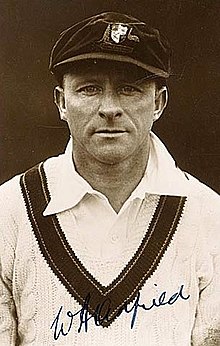Bert Oldfield
 |
||||||||||||||||||||||||||||||||||||||||
| Personal information | ||||||||||||||||||||||||||||||||||||||||
|---|---|---|---|---|---|---|---|---|---|---|---|---|---|---|---|---|---|---|---|---|---|---|---|---|---|---|---|---|---|---|---|---|---|---|---|---|---|---|---|---|
| Full name | William Albert Stanley Oldfield | |||||||||||||||||||||||||||||||||||||||
| Born |
9 September 1894 Alexandria, NSW, Australia |
|||||||||||||||||||||||||||||||||||||||
| Died | 10 August 1976 (aged 81) Killara, NSW, Australia |
|||||||||||||||||||||||||||||||||||||||
| Batting style | Right-handed | |||||||||||||||||||||||||||||||||||||||
| Role | Wicket-keeper | |||||||||||||||||||||||||||||||||||||||
| International information | ||||||||||||||||||||||||||||||||||||||||
| National side | ||||||||||||||||||||||||||||||||||||||||
| Test debut (cap 109) | 17 December 1920 v England | |||||||||||||||||||||||||||||||||||||||
| Last Test | 3 March 1937 v England | |||||||||||||||||||||||||||||||||||||||
| Domestic team information | ||||||||||||||||||||||||||||||||||||||||
| Years | Team | |||||||||||||||||||||||||||||||||||||||
| 1919–1938 | New South Wales | |||||||||||||||||||||||||||||||||||||||
| Career statistics | ||||||||||||||||||||||||||||||||||||||||
|
||||||||||||||||||||||||||||||||||||||||
| Source: Cricinfo, 29 September 2009 | ||||||||||||||||||||||||||||||||||||||||
William Albert Stanley "Bert" Oldfield (9 September 1894, Sydney, New South Wales, Australia – 10 August 1976, Sydney, New South Wales) was an Australian cricket player. He played for New South Wales and the Australian cricket team as wicket-keeper.
He served with the first Australian Imperial Force as a Corporal in the 15th Field Ambulance. He was wounded in 1917 when shot in the leg. At the conclusion of the war he was selected to be part of the Australian Imperial Forces cricket team which played 28 first class matches in Britain, South Africa and Australia.
Oldfield made his first-class cricket debut in England in 1919, and played his first Test match against England in his hometown of Sydney in the 1920-21 season. He was dropped for several matches over the next few years, but established himself as Australia's automatic selection for wicket-keeper in the 1924-25 Ashes series against England.
He missed only one other Test in his career, that being the fourth Test of the 1932-33 Bodyline series. In the notorious third Test at Adelaide, the English Bodyline tactic of bowling fast balls directed at the Australian batsmen's bodies reached its most dramatic moment when fast bowler Harold Larwood hit Oldfield in the head, fracturing his skull (although this was from a top edge off a traditional non-Bodyline ball and Oldfield admitted it was his fault). Oldfield was carried from the ground unconscious. He recovered in time for the fifth Test of the series.
...
Wikipedia
